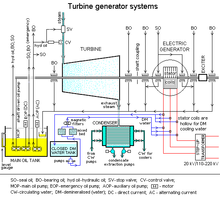Lube oil tank vent
A lubricating oil tank vent is a special circulating system for bearing lubrication in large-scale turbines.
Special case of turbine bearings
Power generation systems with turbines , generators and couplings are usually equipped with shaft bearings which have a contact-free seal , often labyrinth seals . This type of seal has very low friction losses, causes virtually no wear and is also suitable for high speeds. The disadvantage of non-contact seals is that they do not guarantee a 100% seal. Depending on the size of the system, 3 to 7 shaft bearings are normally installed.
The lubricating oil supply for the shaft bearings is usually carried out centrally via a lubricating oil tank. Lubricating oil tanks with a capacity of up to 150,000 liters are used. The lubricating oil is pumped to the bearing points by means of a lubricating oil pump.
The bearings are vented to prevent lubricating oil from escaping at the bearing points. The vent lines from the bearings are fed together into the central lubricating oil tank. A fan sucks air out of the lubricating oil tank and creates a negative pressure in the system, which is usually approx. 6 mbar (depending on pressure losses in the lines). The negative pressure in the shaft bearing space is approx. 4 mbar. Radial high-pressure fans and side channel blowers are preferred as blowers , sometimes in combination with an oil mist separator . Side channel compressors are able to generate negative pressures of up to 100 mbar. They are suitable in connection with oil mist separators, which have high pressure losses across the filter. The energy consumption required for side channel blowers is significantly higher than for high pressure centrifugal fans.
In some cases, the leakage of lubricating oil in the bearings is also prevented by so-called sealing air systems. A compressed air cushion is built up at the ends of the bearing so that no oil can escape. Part of the compressed air reaches the shaft bearing space and via the vent line into the oil tank, which creates a slight overpressure in the tank, which has to be relieved via a vent opening. Active ventilation with a fan is usually not required in connection with sealing air systems.
The high temperatures in the bearings - due to the friction - create a fine oil mist. This oil mist is carried away when the bearings are vented. If there is no oil mist separator or oil mist filter, the oil particles contained in the extracted air are expelled into the atmosphere and cause environmental pollution. This problem also applies to bearing sealing using sealing air.
Environmental aspects
There are still many countries in which there are no legal requirements regarding the leakage of oil. In these countries, the bearings are mostly vented by means of simple fans and the air-oil mixture is discharged into the atmosphere without filtration.
In Germany z. B. this is prevented by the specifications of the TA Luft and the use of an oil mist separator is therefore mandatory.
Oil mist separator for venting the lubricating oil tank
The requirements for oil mist separators for power plants are high, as the oil particles are very fine due to the high temperatures and the low viscosity classes of the lubricating oils used. Different types of oil mist separators can be used depending on the requirements.
The lubricating oil separated in the oil mist separator is fed back into the oil tank, which significantly reduces oil consumption and protects the environment. In most cases, the oil mist separator has a fan on the outlet side, which generates the required negative pressure in the oil tank for venting the bearings. In order to set the desired negative pressure in the bearings or in the oil tank, manual flaps can be used to throttle the suction volume flow from the fan.
Active oil mist separator systems can be equipped with electronic pressure control using a frequency converter in order to keep the negative pressure in the oil tank constant regardless of operating conditions. This brings energetic advantages, extends the service life of the fan and avoids possible entry of dirt particles into the bearing due to excessive negative pressures. Oil mist separators with electronic pressure control are associated with additional costs due to the complexity of the purchase.
The reliability of the fan is important because, under unfavorable conditions, if the fan fails, the oil mist can ignite at so-called hot spots in the warehouse. For this reason, oil mist separators with two redundant fans or for turbines in nuclear power plants are sometimes installed completely redundantly.



